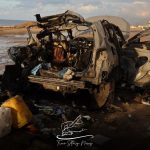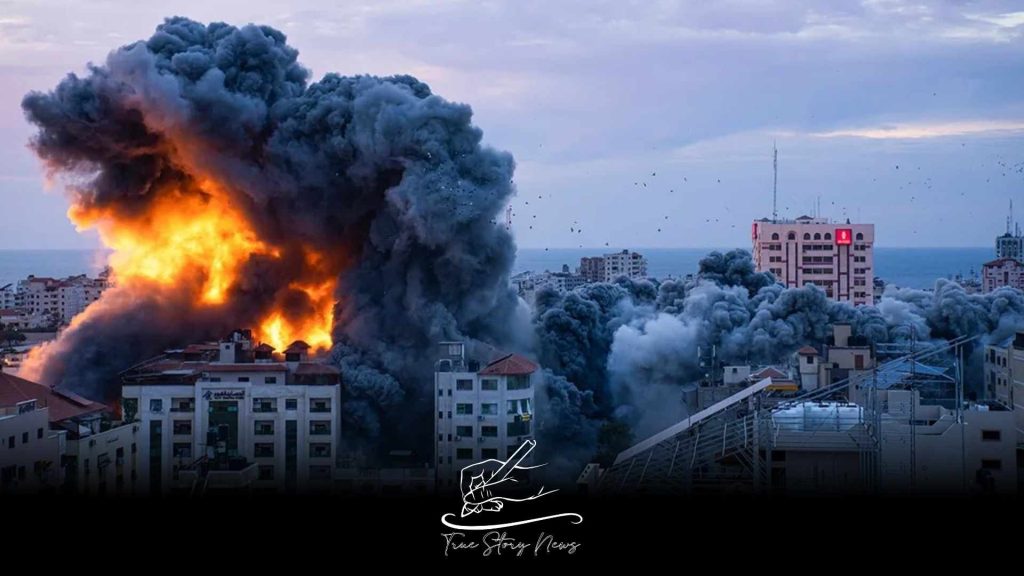Reports from Syrian media indicate that Israeli warplanes have conducted numerous attacks throughout the country, with strikes reported in the capital, Damascus.
The Syrian Observatory for Human Rights, located in the UK, reported that over 100 strikes were conducted on military targets.
Local media reports indicate that a research centre, believed to have connections to chemical weapon production, was among the sites targeted in the recent strikes.
Israel has announced that it is taking measures to prevent weapons from reaching “the hands of extremists” in the aftermath of the Assad regime’s overthrow.
On Monday, the UN Security Council convened to address the circumstances in the country following the ousting of President Bashar al-Assad, announcing plans to draft a statement in the days ahead.
Russian UN Ambassador Vassily Nebenzia addressed reporters, stating that the council appeared largely unified in its commitment to maintaining Syria’s territorial integrity and unity. Nebenzia emphasized the importance of protecting civilians and facilitating humanitarian aid for those in need.
According to the Syrian Observatory for Human Rights, there have been hundreds of Israeli air strikes over the last 48 hours, targeting various locations, including a site in Damascus reportedly utilised for rocket development by Iranian scientists.
The recent strikes coincide with a warning from the UN’s chemical watchdog, urging Syrian authorities to secure suspected stockpiles of chemical weapons.
The Organisation for the Prohibition of Chemical Weapons (OPCW), recognised as the UN’s chemical watchdog, defines a chemical weapon as any chemical designed to inflict intentional death or harm due to its toxic characteristics.
International humanitarian law explicitly prohibits the use of chemical weapons, irrespective of whether a legitimate military target exists. This prohibition is grounded in the indiscriminate nature of the effects these weapons produce.
The exact location and quantity of chemical weapons in Syria remain uncertain. However, there are prevailing beliefs that former President Bashar al-Assad maintained stockpiles and that his previous declarations regarding these weapons were not fully comprehensive.
Syria officially endorsed the OPCW’s Chemical Weapons Certificate in 2013, following a devastating chemical weapons assault on the outskirts of Damascus that occurred just a month prior. This attack, which utilised the nerve agent sarin, resulted in the tragic loss of over 1,400 lives.
The disturbing images of victims writhing in pain have left a profound impact on global audiences. Western powers have asserted that the attack could only have been executed by the government, while Assad has placed the blame on the opposition.
Even after the OPCW and the UN successfully eliminated all 1,300 tonnes of chemicals declared by the Syrian government, incidents of chemical weapons attacks in the region persisted.
A 2018 analysis by the BBC revealed that from 2014 to 2018, there were at least 106 instances of chemical weapons being deployed during the Syrian civil war.
On Monday, the Organisation for the Prohibition of Chemical Weapons (OPCW) announced that it had reached out to Syria to underscore the critical need for safeguarding all materials and facilities associated with chemical weapons within the nation.
On Monday, the Israeli military unveiled images of its forces that moved from the Israeli-occupied Golan Heights into the demilitarised buffer zone in Syria. In this area, UN peacekeepers are stationed.
In a significant development, Israeli Prime Minister Benjamin Netanyahu declared that the military has temporarily taken control of the Area of Separation. This announcement follows his assertion that the 1974 disengagement agreement with Syria has effectively “collapsed” due to the recent rebel takeover of the country.
The Golan Heights, a rugged plateau, is located approximately 60 kilometres (40 miles) southwest of Damascus.
In the final moments of the 1967 Six-Day War, Israel took control of the Golan Heights from Syria, later formalising this action through unilateral annexation in 1981. The action failed to gain international recognition despite the United States taking unilateral steps to acknowledge it in 2019.
During a news conference on Monday, Saar stated that the Israel Defence Forces (IDF) was implementing “a minimal and temporary step” for “security reasons.”
The individual asserted that Israel was not inclined to interfere in Syria’s internal matters, emphasising that its primary focus was the protection of its citizens.
Defence Minister Israel Katz stated that the Israeli military is prepared to “destroy heavy strategic weapons,” which encompasses missile and air defence systems.
Israel’s recent actions follow the capture of Damascus by Syrian rebel fighters, marking a significant shift in the power dynamics of the region as they have succeeded in toppling Bashar al-Assad’s regime. Since 1971, he and his father have maintained their grip on power in the country.
In a significant development, forces associated with the Islamist opposition group Hayat Tahrir al-Sham (HTS) made their way into Damascus during the early hours of Sunday. Shortly after that, they appeared on state television, proclaiming that Syria had achieved a state of “freedom.”
On Tuesday, HTS announced that the incoming authorities plan to release a list detailing the “names of the most senior officials involved in torturing the Syrian people.”
The organisation announced plans to provide incentives for information regarding “high-ranking military and security officials implicated in war crimes.”
The Assad regime garnered significant backing from both Hezbollah and Russia during the ongoing civil war in the country. As Hezbollah engages in the ongoing Israel-Gaza conflict and cross-border air strikes escalate between Israel and Lebanon, Russia continues to allocate significant resources to its invasion of Ukraine. In this context, HTS and other rebel factions in Syria have capitalised on the situation, successfully capturing substantial territories across the country.
In the context of the 2011 Syrian uprising, Israel assessed that Bashar al-Assad, although aligned with Iran and Hezbollah, represented a more favourable option compared to the uncertainties that could emerge after his regime’s potential collapse.
On Sunday, Netanyahu described the downfall of the Assad regime as a “historic day in the Middle East,” asserting that Israel would extend a “hand of peace” to Syrians seeking to coexist peacefully with the nation.
The spokesperson stated that the IDF’s presence in the buffer zone is intended as a “temporary defensive position until a suitable arrangement is found.”
Our priority is to establish neighbourly and peaceful relations with the emerging forces in Syria. “However, if we fail to do so, we will take all necessary measures to protect the State of Israel and its borders,” he stated.
Israel’s sensitivity regarding the Golan Heights is expected to increase, particularly in light of the familial ties of HTS leader Abu Mohammed al-Jawlani to the region. In the region, thousands of Israeli settlers coexist with approximately 20,000 Syrians, predominantly from the Druze community, who remained following the area’s capture.
Israeli airstrikes in Syria have become a recurring event. The organisation has confirmed that it has conducted hundreds of strikes in recent years against targets in Syria, which it claims are associated with Iran and allied armed groups, including Hezbollah.
Since the onset of the Gaza conflict in October 2023, Israeli airstrikes in Syria have reportedly increased in frequency. This escalation appears to be a direct response to cross-border assaults on northern Israel attributed to Hezbollah and various factions in Lebanon and Syria.
In a recent report, the Syrian Observatory for Human Rights (SOHR), a monitoring organization based in the UK, detailed a series of strikes that targeted a weapons depot and additional sites in the vicinity of Palmyra. The attacks resulted in the deaths of 68 fighters, both Syrian and foreign, many of whom were associated with Iran-backed militia groups.













